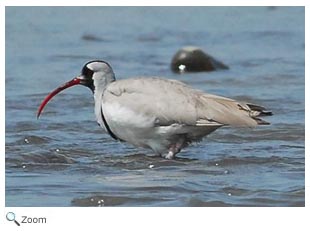Ibidorhynchidae - ibisbill
 The ibisbill is the only species in this family. It is found in south central Asia in Afghanistan, Bhutan, China, India, Kazakhstan, Kyrgyzstan, Myanmar, Nepal, Pakistan, the Russian Federation, Tajikistan, Turkmenistan, and Uzbekistan. It lives at high altitudes near rivers. The ibisbill is the only species in this family. It is found in south central Asia in Afghanistan, Bhutan, China, India, Kazakhstan, Kyrgyzstan, Myanmar, Nepal, Pakistan, the Russian Federation, Tajikistan, Turkmenistan, and Uzbekistan. It lives at high altitudes near rivers.
The ibisbill has a long, downward curved and sharply-pointed pink bill; a gray body; a white belly with a black band on its chest; and a black face.
The ibisbill uses its long bill to probe under rocks for small fish and invertebrates. Except during the breeding season, the ibisbill is a solitary bird. The ibisbill nests in a scrape that is made on a riverbank. The female lays 3-4 eggs and both the male and the female share incubation duties.
World Status Key
 Least Concern Least Concern  Near Threatened Near Threatened  Vulnerable Vulnerable  Endangered Endangered  Critically Endangered Critically Endangered  Extinct in Wild Extinct in Wild  Extinct Extinct
Status taken from ICUN Redlist. If no status is listed, there is not enough data to establish status, or there is no status data for the species.
US Status Key
 Threatened in US Threatened in US  Threatened in NH Threatened in NH  Endangered in US Endangered in US  Endangered in NH Endangered in NH  Introduced Introduced
Status taken from US Fish and Wildlife and NH Fish and Game
New Hampshire Species |
|
North/Central American Species |
| None |
|
None |
Additional Information
Resource Key
 Profile Profile  Photos Photos  Video Video  Audio Audio
Ibisbill - Ibidorhyncha struthersii     
The ibisbill is found near stony rivers.
Source: Internet Bird Collection Intended Audience: General Reading Level: Middle School
|

